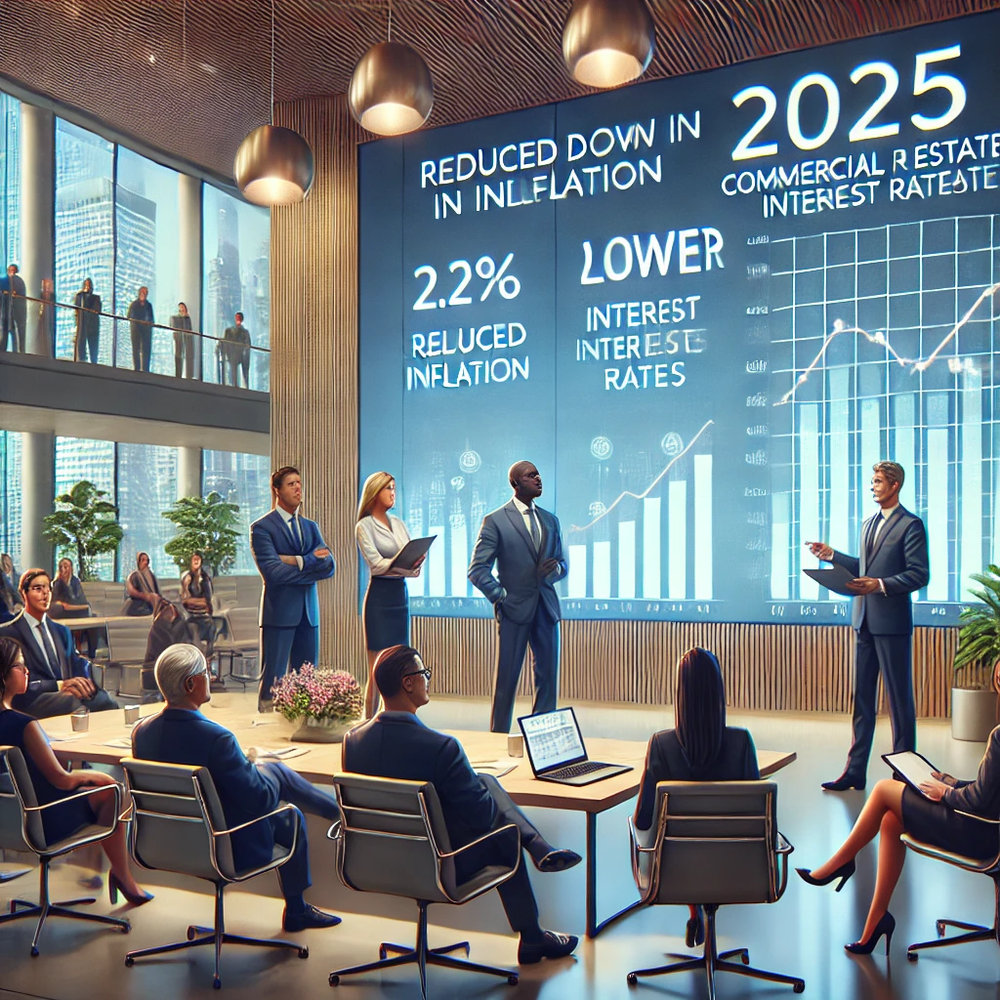As we approach 2025, the commercial real estate market is poised for significant changes, particularly in interest rates. While recent years have seen fluctuating rates due to inflation, monetary policy, and market conditions, there is growing optimism that interest rates may decline. This potential decrease could be driven by factors such as changes in monetary policy, slowing inflation, increased market stability, and a more balanced supply-demand dynamic. Understanding these drivers is essential for investors and industry professionals as they plan for the future.
Table of Contents:
- What economic factors could contribute to a reduction in commercial real estate interest rates by 2025?
- How might changes in monetary policy influence lower commercial real estate interest rates in 2025?
- What role could increased market stability play in driving down commercial real estate interest rates in 2025?
- How might a slowdown in inflation impact commercial real estate interest rates in 2025?
- What effect could a stronger supply-demand balance in the commercial real estate market have on interest rates by 2025?
What economic factors could contribute to a reduction in commercial real estate interest rates by 2025?

Several economic factors could contribute to a reduction in commercial real estate interest rates by 2025:
- Slower Economic Growth: If the global economy experiences slower growth, central banks might lower interest rates to stimulate investment and spending, which could lead to lower commercial real estate interest rates.
- Decreasing Inflation: A significant decline in inflation rates could prompt central banks to reduce interest rates to maintain economic momentum, directly impacting commercial real estate financing costs.
- Monetary Policy Adjustments: Central banks may shift to more accommodative monetary policies if economic conditions require it, such as by lowering the federal funds rate or implementing quantitative easing, which could result in lower borrowing costs for commercial real estate.
- Increased Market Liquidity: If financial markets become more liquid, with more capital available for lending, competition among lenders could drive down interest rates on commercial real estate loans.
- Global Economic Conditions: A weaker global economy could lead to lower demand for high-yield investments, driving investors towards safer assets like government bonds. This shift could lower long-term interest rates, indirectly reducing commercial real estate interest rates.
The reduction in commercial real estate interest rates by 2025 could be influenced by a combination of slower economic growth, decreasing inflation, and more accommodative monetary policies. Additionally, increased market liquidity and shifts in global economic conditions may also play significant roles. These factors together could create a more favorable borrowing environment for commercial real estate, making it a more attractive investment option as we approach 2025.
How might changes in monetary policy influence lower commercial real estate interest rates in 2025?
Changes in monetary policy can significantly influence lower commercial real estate interest rates by 2025 through the following mechanisms:
- Reduction in Benchmark Interest Rates: Central banks, such as the Federal Reserve, may lower benchmark interest rates to stimulate economic activity. This reduction directly affects the interest rates that banks charge for loans, including commercial real estate loans, making borrowing cheaper.
- Quantitative Easing (QE): If central banks decide to implement or expand quantitative easing programs, they purchase large quantities of government and other securities. This action increases the money supply and lowers long-term interest rates, which can translate into lower interest rates for commercial real estate financing.
- Forward Guidance: Central banks might use forward guidance to signal to the market that they intend to keep interest rates low for an extended period. This communication can influence market expectations, leading to lower interest rates in the commercial real estate sector as lenders anticipate a prolonged period of low rates.
- Inflation Targeting: Central banks often adjust monetary policy to keep inflation within a target range. If inflation is lower than the target, the central bank may lower interest rates to encourage spending and investment, including in commercial real estate, thereby reducing borrowing costs.
- Global Monetary Coordination: In a globally interconnected economy, coordinated efforts by central banks around the world to maintain low-interest rates can have a ripple effect, leading to reduced interest rates in various sectors, including commercial real estate.
Monetary policy changes can have a profound impact on commercial real estate interest rates. By reducing benchmark rates, implementing quantitative easing, and providing clear forward guidance, central banks can create an environment that encourages lower borrowing costs in the commercial real estate market by 2025. These policies not only make real estate investments more attractive but also support overall economic growth.
What role could increased market stability play in driving down commercial real estate interest rates in 2025?
Increased market stability can play a significant role in driving down commercial real estate interest rates in 2025 through several key mechanisms:
- Lower Risk Premiums: When markets are stable, lenders perceive less risk in lending. This reduced risk leads to lower risk premiums, which are typically added to interest rates to compensate lenders for the potential of defaults or other financial uncertainties. As market stability increases, these premiums decrease, resulting in lower interest rates for commercial real estate loans.
- Increased Investor Confidence: Stability in the broader financial markets often leads to higher investor confidence. When investors feel secure, they are more likely to invest in commercial real estate, driving up demand. This increased demand for real estate assets can lead to more competitive lending terms, including lower interest rates, as lenders vie to finance these investments.
- Steady Economic Growth: Market stability is often accompanied by steady economic growth, which can lead to predictable income streams for commercial properties. When lenders can confidently project stable cash flows from commercial real estate, they are more willing to offer lower interest rates as the risk of loan default decreases.
- Reduced Volatility in Interest Rates: A stable market environment typically experiences less volatility in interest rates. Lenders, therefore, face fewer uncertainties about future rate hikes, allowing them to offer lower and more stable interest rates on long-term commercial real estate loans.
- Enhanced Credit Conditions: Stable markets usually lead to improved credit conditions, with banks and other financial institutions becoming more willing to extend credit. As credit becomes more accessible and less costly, commercial real estate borrowers can benefit from lower interest rates.
Increased market stability can significantly contribute to driving down commercial real estate interest rates by 2025. By reducing risk premiums, boosting investor confidence, and fostering a predictable economic environment, stability can create more favorable lending conditions. This environment encourages lower borrowing costs, making commercial real estate investments more attractive and accessible.
How might a slowdown in inflation impact commercial real estate interest rates in 2025?

A slowdown in inflation could impact commercial real estate interest rates in 2025 in several important ways:
- Lower Central Bank Rates: When inflation slows, central banks may have less pressure to raise interest rates to combat rising prices. In fact, if inflation falls significantly, central banks might reduce benchmark interest rates to stimulate economic activity. Lower central bank rates typically translate to lower commercial real estate interest rates, as the cost of borrowing decreases across the economy.
- Reduced Inflation Premium: Lenders often include an inflation premium in the interest rates they charge to account for the expected erosion of purchasing power over time. If inflation slows, the need for such a premium diminishes, leading to lower interest rates on commercial real estate loans.
- Increased Investment Stability: Slower inflation can create a more stable economic environment, which is favorable for long-term investments like commercial real estate. As the risk of unpredictable inflation decreases, lenders may offer lower interest rates, reflecting the reduced uncertainty and greater confidence in the economy’s stability.
- Enhanced Purchasing Power: As inflation slows, the real value of money increases, enhancing purchasing power. This improvement means borrowers may have more capital available for investment, which could lead to increased competition among lenders to attract commercial real estate borrowers. This competition can drive interest rates down further.
- Improved Market Sentiment: A slowdown in inflation can improve overall market sentiment, leading to more favorable credit conditions. Lenders may become more willing to offer lower interest rates if they believe the economic environment will remain stable and inflation will stay under control, reducing the risk of future rate hikes.
A slowdown in inflation can lead to lower commercial real estate interest rates in 2025 by reducing the need for central banks to maintain high benchmark rates, lowering the inflation premium in loan pricing, and creating a more stable and favorable investment environment. These factors together can result in more attractive borrowing costs for commercial real estate investors, further stimulating the market.
What effect could a stronger supply-demand balance in the commercial real estate market have on interest rates by 2025?
A stronger supply-demand balance in the commercial real estate market could have several effects on interest rates by 2025:
- Stabilization of Property Values: A balanced supply-demand dynamic helps maintain stable property values. When property values are stable, lenders face less risk of significant price fluctuations, leading to lower interest rates on commercial real estate loans. This stability reduces the risk premiums that lenders typically add to interest rates to compensate for potential volatility.
- Reduced Speculative Pressure: In a balanced market, speculative bubbles are less likely to form. When demand does not drastically outpace supply, there is less risk of an overheated market, which can lead to sharp corrections. The reduced risk of such market corrections makes lenders more comfortable offering lower interest rates.
- Enhanced Lending Confidence: A healthy balance between supply and demand signals a stable and predictable market environment. Lenders are more confident in extending credit when they perceive that the market is not prone to sudden swings. This confidence can result in more favorable loan terms, including lower interest rates for commercial real estate borrowers.
- Competitive Lending Environment: A balanced market can lead to increased competition among lenders. When the supply of commercial real estate properties meets demand, there is typically a steady flow of transactions. To attract borrowers in such an environment, lenders may offer more competitive interest rates, driving overall rates down.
- Sustainable Growth Prospects: A well-balanced market suggests sustainable growth rather than boom-and-bust cycles. Sustainable growth prospects reduce the perceived risk of long-term investments, leading to lower interest rates as lenders are less concerned about future economic downturns affecting the commercial real estate sector.
A stronger supply-demand balance in the commercial real estate market by 2025 could lead to lower interest rates by stabilizing property values, reducing speculative risks, and enhancing lender confidence. In such an environment, borrowers can benefit from more competitive loan terms, making commercial real estate investments more accessible and attractive. This balanced market could promote long-term growth and stability in the sector.
A confluence of factors could contribute to a reduction in commercial real estate interest rates by 2025. Changes in monetary policy, such as lower benchmark rates and quantitative easing, alongside a slowdown in inflation, could create a favorable environment for lower borrowing costs. Increased market stability and a stronger supply-demand balance in the commercial real estate market would further support this trend by reducing risk premiums, enhancing lender confidence, and fostering a more competitive lending environment. Collectively, these factors could make commercial real estate a more attractive and accessible investment, promoting sustained growth and stability in the sector as we approach 2025.
Take Advantage of Lower Interest Rates – Act Now!
The commercial real estate landscape is evolving, and with interest rates expected to drop in 2025, now is the perfect time to invest, refinance, or expand your portfolio.
📞 Call us today: 502-536-7315
📧 Email us: raphael@sumcg.com
Let’s strategize your next move and position you for success in the changing market. Reach out now to explore your opportunities!
